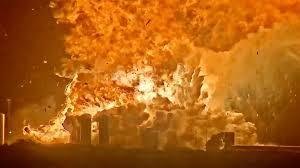Introduction: Shockwaves from the Starbase
Earlier today, a stunning event shook the aerospace world. During a planned routine test, a SpaceX rocket explosion sent a shockwave across the skies above Starbase Texas, leaving fans, followers, and engineers in disbelief. Videos of the SpaceX crash quickly flooded social media, showing the massive fireball as the Starship explodes in what experts are calling a catastrophic test anomaly.
While SpaceX is no stranger to high-stakes experimentation, this particular incident has sparked intense discussions online and in aerospace circles. Footage of the SpaceX starship explosion has already gained millions of views, raising questions about what went wrong and how this might affect future launches.
This wasn’t just any test—this was meant to push the Starship program forward toward deep space goals. However, the SpaceX explosion today now becomes a serious topic for analysis. Fans of innovation and critics alike are looking closely at Elon Musk’s Starship project and the risks it involves.
As we explore the events and implications of this dramatic setback, stay with us for a deeper look into what caused the explosion and what this means for SpaceX today.
What Happened? Starship Test Ends in Fireball
Onlookers around Starbase Texas were stunned as the test flight of Starship SN36 ended in a massive explosion, often referred to in aerospace circles as a Rapid Unscheduled Disassembly (RUD). The goal was a routine test of booster performance, but something went wrong during the ignition sequence, leading to a fireball that lit up the skies—instantly pushing SpaceX rocket explosion into global headlines.
Footage of the event quickly made its way online, many watching via the rocket launch livestream. Spectators could see the spacecraft rising before it suddenly vanished in flames. Analysts believe it might have been a booster separation failure, possibly related to software or pressure buildup. As the Starship explodes, all eyes turned to the company’s track record of testing risky hardware in pursuit of innovation.
The SpaceX starship explosion drew parallels to past explosive tests, though each serves as a stepping stone in SpaceX’s rapid development cycle. Engineers will now pore over rocket telemetry data, hoping to pinpoint what triggered this dramatic failure.
For now, the event stands as a visual and emotional marker of the risks behind big dreams—and why moments like this still push the boundaries of engineering progress in the pursuit of the stars.
Elon Musk’s Statement & Company Reaction
Soon after the incident, Elon Musk’s response to the rocket explosion captured worldwide attention. Taking to his favorite platform, he acknowledged the fiery setback while praising the team for making it as far as they did. Musk framed the SpaceX rocket explosion as an opportunity to learn, stating that progress in rocket science often comes at the cost of trial—and sometimes fire.
The company emphasized that no crew was onboard, and safety measures were fully in place. The SpaceX engineering team has already begun reviewing data logs and footage to understand what triggered the failure. Discussions are centering around a potential booster separation failure or heat shield compromise, though no official cause has been confirmed.
In a public briefing, a spokesperson reassured that this was a controlled test flight, part of the company’s iterative design method. Meanwhile, the FAA’s investigation into SpaceX is underway, as is standard for high-profile rocket incidents. While the mood at Starbase Texas may be somber, the team remains committed to pushing forward.
In true SpaceX fashion, this response highlights resilience. Lessons from this setback will feed directly into upcoming designs, with updated protocols and checks likely to be implemented in the next SpaceX starship test.
What This Means for Future Missions
The recent SpaceX rocket explosion may feel like a major setback, but within the company’s rapid development philosophy, failures like these are often considered stepping stones. However, there’s no doubt that this incident could temporarily shift momentum in SpaceX’s timeline—especially for missions tied to the Mars program and future SpaceX booster landing tests.
Experts suggest that the booster separation failure may trigger a deeper redesign of structural or software systems. It’s also possible that the heat shield damage seen in previous flights played a role. These kinds of issues will need close investigation before moving toward crewed missions or deeper interplanetary goals. While there’s no official delay yet, disruptions in testing could impact the broader Mars mission delay conversation in aerospace circles.
Additionally, potential launch pad damage may require repairs at Starbase Texas, temporarily halting testing activities. The engineering team will likely revisit procedures and equipment, which could include a deeper look into SpaceX launch scrub protocols and stage recovery systems.
Still, SpaceX is known for its resilience. Each crash brings them closer to breakthroughs. The mission now is to rebuild smarter, stronger—and keep pushing toward the dream of interplanetary travel.
Internet Reacts: Memes, Opinions & Fallout
As soon as the SpaceX rocket explosion footage surfaced online, the digital world erupted with reactions. On platforms like X (formerly Twitter), Reddit, and YouTube, users flooded the feeds with shock, speculation, and a surprising wave of humor. The phrase “Starship explodes” trended globally within hours, generating massive engagement and spawning a wave of SpaceX explosion memes that ranged from cheeky satire to outright absurdity.
Commentators across forums offered rocket explosion video analysis, breaking down every frame of the test failure. Space fans debated causes, engineers speculated about system faults, and some shared support for Elon Musk’s Starship ambitions despite the failure. One Redditor called the event “another chapter in rapid prototyping,” while others reposted clips labeled as “SpaceX explosion today” with humorous captions or dramatic music overlays.
Of course, not every response was lighthearted. Critics raised questions about safety, waste, and accountability, particularly around Starbase Texas operations. Still, the community remains largely supportive of the trial-and-error nature of space innovation—viewing this explosion as part of a larger, historic mission.
In this age of viral content, even a setback becomes a spectacle. And for SpaceX, the attention—good or bad—keeps the public fixated on what’s coming next.
Looking Forward: What’s Next for SpaceX?
Despite the dramatic SpaceX rocket explosion, the company remains undeterred. Known for its “fail fast, learn faster” approach, SpaceX is already gearing up for the next steps. Engineers are sifting through rocket telemetry data to find answers, while damage assessments are underway at Starbase Texas. The goal: bounce back with improvements, not setbacks.
A key focus will be refining the booster landing system. Previous tests have shown progress in vertical landings, but the explosion brings renewed urgency to perfect this technology. Updates to SpaceX safety protocols are also expected, as lessons from the failure shape future procedures and designs.
While the explosion might slow things short-term, SpaceX’s broader vision remains unchanged. Upcoming test flights could see retooled hardware, upgraded flight computers, and adjusted risk models. Some analysts suggest we may see a more cautious approach in the next SpaceX starship cycle, possibly including minor redesigns or extended simulation phases before live tests resume.
One thing is clear—SpaceX isn’t hitting pause. The explosion marks another twist in a bold journey toward Mars and beyond. For now, we watch and wait, as the company turns a fireball into fuel for what comes next.
FAQ
Q1: Why did the SpaceX rocket explode today?
The exact cause is still under investigation, but early reports suggest a booster separation failure may have triggered the fiery event. Engineers are reviewing rocket telemetry data to understand the malfunction.
Q2: Was this the same rocket Elon Musk plans to send to Mars?
Yes, the test involved Elon Musk’s Starship system. This prototype plays a vital role in SpaceX’s long-term vision for deep space missions, including those aimed at the Moon and Mars.
Q3: Is there a video of the rocket explosion?
Yes, the event was captured during a rocket launch livestream and has since gone viral. Many have analyzed and shared the rocket explosion video across social platforms.
Q4: Will this delay upcoming SpaceX launches?
Possibly. While there’s no official schedule change, this incident could result in a SpaceX launch scrub or slowdowns as engineers focus on improving systems and safety protocols.
Q5: What is RUD in rocket science?
RUD stands for Rapid Unscheduled Disassembly, a somewhat humorous term used to describe catastrophic rocket failures like the SpaceX starship explosion.
Q6: How did the internet react to the explosion?
With mixed emotions. While many expressed concern, others reacted with humor, creating SpaceX explosion memes and commentary. It trended as SpaceX explosion today within hours.
Q7: Will SpaceX continue testing?
Absolutely. Despite the explosion, SpaceX today is as committed as ever. The next test will integrate lessons learned, new safeguards, and possibly updated designs.
STAY TUNED AT PAK SPECTRUM FOR MORE!





